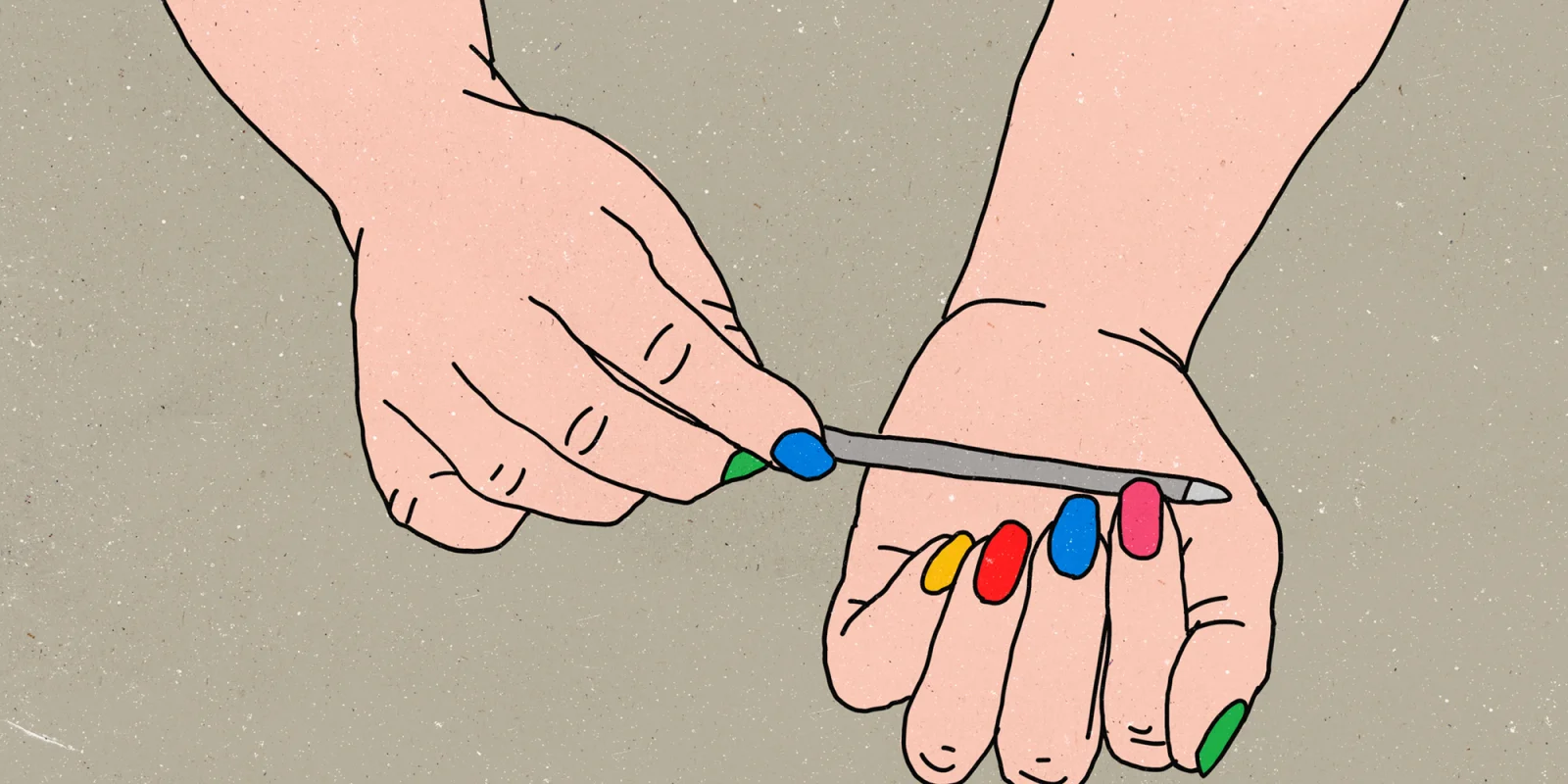 Less than half an inch square, the alpha-keratin slabs on the dorsa of our fingers and toes serve many of the same functions as their evolutionary precursors, claws and hooves: our nails protect our fingertips and distal phalanges from trauma, allow us to scratch off bugs and dirt, and provide counter-pressure that helps us sense, grasp, and walk. These tiny appendages are also brimming with information about who we are—and not just because of the way we paint them.
Less than half an inch square, the alpha-keratin slabs on the dorsa of our fingers and toes serve many of the same functions as their evolutionary precursors, claws and hooves: our nails protect our fingertips and distal phalanges from trauma, allow us to scratch off bugs and dirt, and provide counter-pressure that helps us sense, grasp, and walk. These tiny appendages are also brimming with information about who we are—and not just because of the way we paint them.
Yet paint them we do. Women and men have been decorating their nails for most of human history, of course. As far back as 5000 BCE, women in China, Egypt and India painted henna onto their fingernails. Ancient Babylonians used kohl to color their nails black or green; the ancient Chinese slathered on egg and beeswax dye; sixteenth-century Incas painted eagles on their nails.
Royalty of nearly every age and place have been particularly fond of nail decor. Queen Nefertiti, King Tutankhamen, and Cleopatra all colored their nails. A Ming dynasty manuscript pegged black and red nail tints as a sign of nobility, while Zhou dynasty royals signaled their status by wearing gilded 6-inch nail guards. It wasn’t just nails that were gilded: among the artifacts discovered in royal tombs from the ancient Babylonian city of Ur was a solid gold manicure set, complete with scissors and nail clippers.
Recent sovereigns are no exception. Queen Elizabeth has reportedly worn the same shade of pink for decades (Essie’s “Ballet Slippers,” which her 1989 hairdresser once called “the only color Her Majesty would wear”). For those keeping track, Kate Middleton apparently wore the slightly more nude Essie Allure for her wedding, while Meghan Markle made headlines for wearing a near-black nail lacquer at the 2018 British Fashion Awards.
Stateside, nail care has occupied a prominent place in American grooming from the earliest days of the nation. The word pedicure (from the Latin “pes” for foot and “cure” for care) may have been coined by none other than Thomas Jefferson. Though nail salons existed as far back as ancient Egypt, the first modern nail salon opened in 1878 in—where else—Manhattan.
Short, round, neutral nails that were easy to keep clean dominated U.S. nail trends early on. That changed in the early 20th century: Revlon’s 1932 launch provided access to a rainbow of colors. Meanwhile, the shift from black-and-white to color television gave icons like Elizabeth Taylor the chance to flaunt siren-red nails. Shades of red and pink largely dominated for the next few decades, until the invention of the French manicure in 1978. Today’s American consumers are not quite as uniform in taste, wearing a wide range of colors from neutral to bold, and propelling nail salon revenue in the U.S. to an estimated $8 billion a year.
Manicures, of course, are not without risk. Gel manicures that require UV light to harden can exacerbate photosensitive skin conditions like lupus and dermatomyositis, contribute to skin photoaging, and potentially increase risk for skin cancer. Recently-trendy fish pedicures have been associated with onychomadesis (shedding of the nails), while run-of-the-mill pedicures have caused atypical mycobacterial and staph infections, leading to at least one death from sepsis. Cutting the cuticle, which acts as a barrier against infection, is a risk factor (and a bad idea).
Protecting us from infection is just the beginning, medically speaking. From the fifteenth week of embryonic life to the time we die, our nails are constantly regenerating themselves. Nails grow faster in young people and pregnant women, and slower at night and during the winter. Toenails grow about a millimeter per month; fingernails at two or three times that rate. The current Guinness World Record holder for longest fingernails grew them for nearly three decades, achieving a length of more than 28 feet.
Nails are also diagnostic tools. Their composition is revealing: nail clippings can be used to quantify exposure to narcotics or nicotine. Nail selenium content has been studied as a biomarker for several types of cancer. Police in Wisconsin collected nail clippings from repeat drunken drivers for a pilot program studying biomarkers of alcohol intake over weeks to months.
Nail color matters, too: White transverse bands known as Mees’ lines can signal arsenic poisoning or leprosy. Green nails suggest bacterial colonization with pseudomonas. So-called half-and-half nails, characterized by proximal nail whiteness and distal redness, are common in patients on hemodialysis; Terry’s nails (with more white than red) may be a sign of liver cirrhosis. Blue lunulae suggest hepatolenticular degeneration or argyria.
And nail shape is equally revealing. Nail pits of different shapes and configurations can be signs of inflammatory conditions, such as psoriasis, atopic dermatitis or alopecia areata. Koilonychia, or spoon nails, can be normal in infants but may signal iron deficiency or coronary artery disease in adults. Beau’s lines, or transverse nail plate grooves resulting from the interruption of nail synthesis during an acute illness or other shock to the body, can be a lasting marker of everything from viral infection to cytotoxic drug exposure. With all those clues to our inner selves visible on our nails, who needs polish?
Image by Malte Mueller / gettyimages
Dr. Laura Fitzpatrick is a resident physician in Dermatology at Northwell Health in New York. A Weill Cornell Medicine grad, she was a full-time writer and reporter for TIME Magazine before starting medical training. Laura is a 2018–2019 Doximity Author. You can follow her on Twitter @L_Fitzpatrick and on Instagram @nydermdoc.







